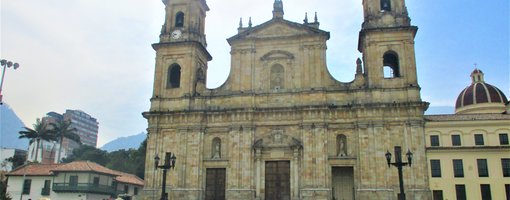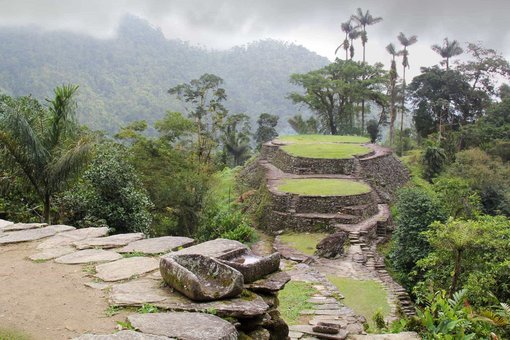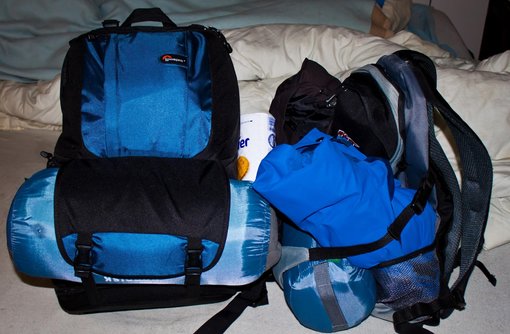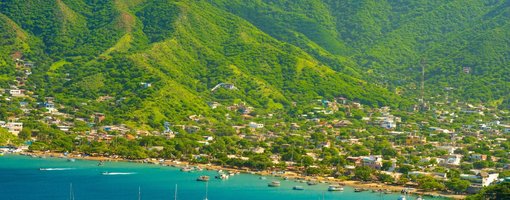Colombia offers a great number of beautiful small towns (pueblos) across its territory, rich in architecture, culture and history. From colonial centres founded in the 16th century during the Spanish colonisation to traditional unique-style coffee towns dating back to the 19th century, there are unlimited options to explore. What make these places so special is their identity and cultural heritage that are still prevalent today. This article outlines seven of our favourite heritage towns in Colombia.
Barichara
In the department of Santander, in the northeast of Colombia, you'll find one of the most photographed and enchanting places in the country, the heritage town of Barichara. The historic centre of Barichara preserves its colonial architecture since the beginning of the 18th century and the authentic atmosphere of that period with the beautiful cobblestone streets and the Andalusian style buildings.
There are plenty of attractions in Barichara worth to visit: the impressive Cathedral of the Immaculate Conception located in the main plaza, the Santa Barbara church and the open-air museum at the Park for the Arts Jorge Delgado Sierra that hosts several stone-carved sculptures. There is also the mirador of El Salto del Mico -one of the best viewpoints in Barichara- which offers stunning views over the canyon of the Suarez River, the National Park Serranía de los Yariguies, and the towns of Galán, La Fuente and Zapatoca. The best way to explore Barichara is either walking or by tuk-tuk which will take you to the most iconic streets of the town.
Another great activity is to walk the old road of Lengerke (Camino Real de Lengerke), a cultural journey that connects some of the most beautiful colonial towns of Santander: Barichara, Guane and Zapatoca. The walk from Barichara to Guane takes 2-3 hours (about 6 kilometres) depending on your pace. In Guane you can visit the Archaeological and Paleontological Museum that exhibits millions of years old fossils, ceramics and other objects of the Guane indigenous people. The route from Guane to Zapatoca is more challenging, as it takes 8-9 hours (about 23 kilometres) and requires very good physical condition. If you decide to do it, we recommend you spend the night before in Guane and set out to Zapatoca early in the morning.
The Santander region is famous for its gastronomy and in Barichara you'll find various restaurants where you can try its traditional dishes. Among those are the famous hormigas culonas or “big-bottomed” ants (roasted ants, previously cleaned and seasoned), the mute (thick soup made of beef ribs, pork, intestines, corn and other vegetables), the arepa santandereana (yellow corn cake grilled on charcoal), the cabrito (lamb or goat meat roasted, grilled or fried) and the sabajón (sweet and creamy liquor).
The fastest way to get to Barichara is to take a flight from one of the major cities of Colombia to Bucaramanga, the capital city of Santander. The distance from Bucaramanga to Barichara is 120 kilometres (about 3 hours' drive). On the way you will have the opportunity to enjoy the amazing landscape, as you will be surrounded by the Andean mountains of the eastern cordillera.
In short distance from Barichara you'll find the small town of San Gil, famous for the extreme sports and adventure tourism. The imposing mountains, rivers and canyons of the region offer the perfect setting for activities like paragliding, white water rafting, caving and rock climbing.
Accommodation in Barichara is available here.
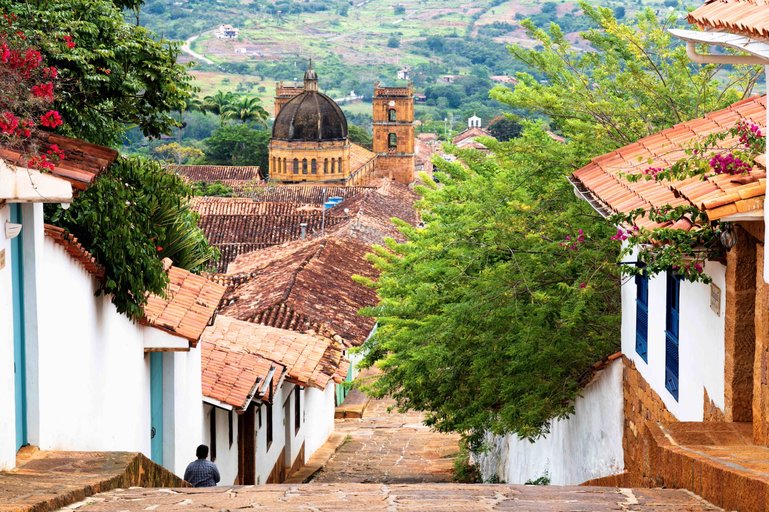
Barichara, Santander
Villa de Leyva
This is probably one of the most visited heritage towns which dates back to 1572. Villa de Leyva is located just three hours away from Bogotá, in the department of Boyacá. Due to its high altitude (2,149 metres above sea level) the weather can be quite chilly, especially during the night. The town is famous for its beautiful colonial architecture and the rural surrounding landscapes.
Villa de Leyva offers various activities to do and things to see, that's why it's worth to stay at least one night. Walk around the cobblestone streets with the whitewashed buildings and the brick tile roofs. Visit the Plaza Mayor, the town's main square and largest in Colombia, surrounded by restaurants, cafés and tourist shops. On the eastern side of the square you will find the old church of Nuestra Señora del Rosario, built in 1604, of colonial baroque architecture. You can also visit the Fossil Museum which features remains of prehistoric animals, or the Paleontological Museum that houses a great collection of treasures and fossil discoveries.
Another interesting attraction is the Terracotta House. This extraordinary piece of pottery, a 500 square metres brick coloured building, is made entirely of clay and can be fully habitable. Lastly, treat yourself to a delicious home-cooked style meal in one of the traditional family-run restaurants of the town.
Not far from Villa de Leyva, about 24 kilometres away, there is Ráquira – a small village famous for its pottery products. In Ráquira you can visit the local stores with handicrafts or take a tour to one of the traditional pottery workshops and watch the artisans working with clay.
Accommodation in Villa de Leyva in available here.
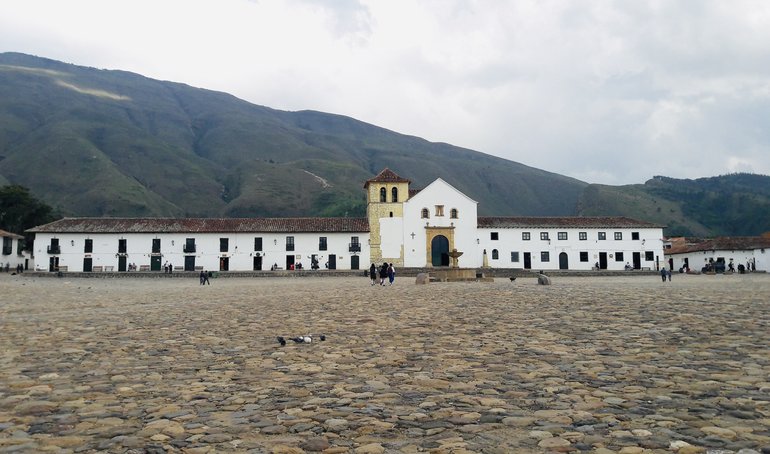
Villa de Leyva, Boyacá
Honda
Honda is one of Colombia's oldest towns, founded by the Spanish in 1539. It's also known as the “city of bridges” as it features more than 40 bridges that cross the Magdalena River. The town is located in the department of Tolima, about a four-hour drive from Bogotá. In the 16th and 17th century, Honda was a port town of great commercial importance due to its strategic location on the banks of the Magdalena River – one of Colombia's major rivers that crosses almost half the country from the southwest, where the Andes split into the three cordilleras, to the north reaching the Caribbean Sea at the city of Barranquilla.
Wander around its narrow roads, such as the famous and most visited Calle de las Trampas, to appreciate the architecture of the old colonial buildings in the historic centre of Honda. You can also walk along the Magdalena River and get to know some of its most emblematic bridges. Another good plan is to visit the most striking building in the town, the Plaza de Mercado. Painted in green and white colours, decorated with archways and large columns, this former convent today offers great varieties of fruits and vegetables as well as clothes.
Keep in mind that the weather in Honda is very hot. We recommend you use sun block, comfortable shoes, light clothes and keep yourself hydrated.
Accommodation in Honda is available here.
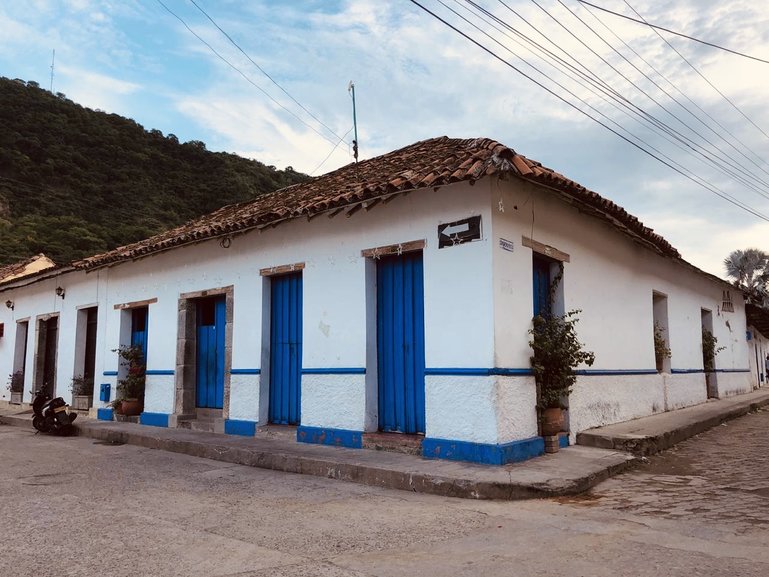
Honda, Tolima
Mompox
Mompox is another important town that makes part of the touristic network of the heritage towns of Colombia. Located in the department of Bolívar near the Caribbean coast, this magical remote little town makes you feel that is frozen in time. The famous Colombian novelist and Nobel Prize winner, Gabriel García Márquez, makes a reference to this absence of time in his book The General in his Labyrinth: “Mompox does not exist. Sometimes we dream about it, but it does not exist”. Although it's a long way to get to Mompox (about 6 hours by car from Cartagena), it's definitely a place not to be missed.
Mompox was one of the first towns founded by the conquistadors in the 16th century on the banks of the Magdalena River. It also played a major role during the Spanish colonisation in the growth of trade from the 17th to the 19th century due to its key location.
The town will impress you with its beautiful buildings, the old cobbled streets, the Caribbean vibe, the exquisite gastronomy and fascinating culture. The historic centre of Mompox is declared as a world heritage site by UNESCO, as it preserves its authenticity and offers an exceptional sample of the Spanish colonial architecture. Contrary to the majority of Colombian towns that have one central plaza, Mompox has three plazas lined up along the river, each one with its own church. When you walk around the streets of the town, you'll notice the distinct religious heritage portrayed in its various churches, including the church of Santa Barbara, the Immaculate Conception and San Francisco.
Lastly, you cannot leave Mompox without tasting the local gastronomy and traditional dishes. Among other foods, here you'll try queso de capa (cheese in layers), fresh fish, butifarra (local sausage) and lemon delicacies. This is a place where you need to open your senses, talk to its people, get lost in the streets and, eventually, discover it yourself.
Ps. If you're planning to travel to Mompox in October, don't miss the famous International Jazz Festival that takes place that month every year.
Accommodation in Mompox is available here.
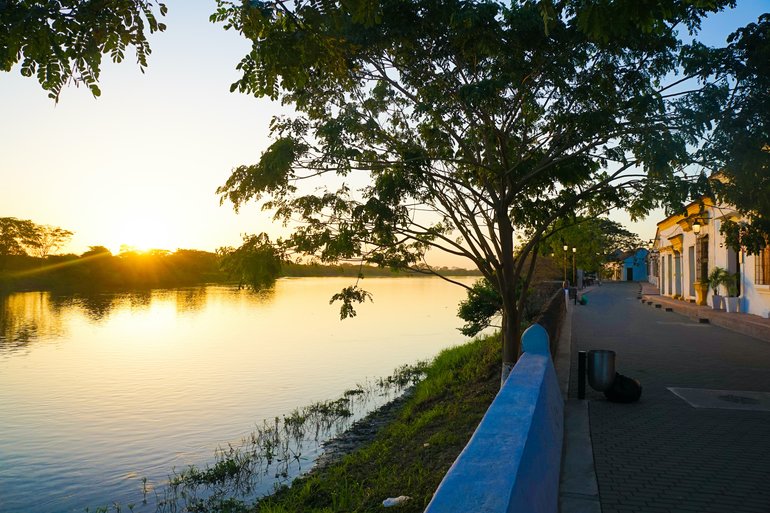
Mompox, Bolívar
Guatapé
Easy to reach from Medellín, Guatapé is one of the most colourful towns in Colombia located in the department of Antioquia. Founded in the 19th century, today Guatapé is an important centre of hydroelectric power production thanks to its large reservoir. It's famous for the colourful houses decorated with extraordinary embossments on their façade, known as zócalos, which display scenes from the history and everyday life. The best way to explore this town is to walk around the charming streets, such as the Calle del Recuerdo, visit the main square of Guatapé and the Plazoleta del Zócalo with the elaborate craft stores and cafés around it.
Guatapé is also renowned for the massive 200 metres-high rock, Piedra del Peñol. This impressive monolith is located in short distance from the main town square and it's definitely worth to try climbing up to its top. The ascent is quite challenging, as you'll need to go up the 675 steps that lead to the viewpoint, but your effort will reward you with an incredible panoramic view over the reservoir. Don´t miss to try a local michelada (cold beer served with lemon and salt) or a fresh juice by the end of your visit. The Piedra del Peñol is open to visitors from 8:00 to 18:00 every day.
The area around the reservoir is ideal for enjoying some moments of relaxation and tranquillity in the nature. You can also spend the night in one of the inviting ecolodges that are built on the shores of the lake and offer great views to the surrounding landscape.
Accommodation in Guatapé is available here.
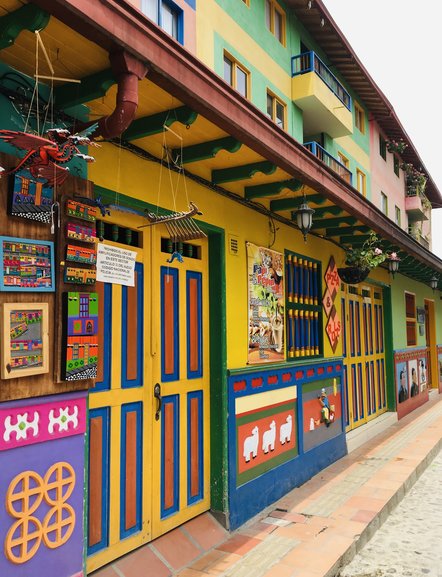
Guatapé, Antioquia
Salento
Salento is an enchanting coffee town in the department of Quindío characterised by its colourful houses and hospitable people. It's built at nearly 1,900 metres above sea level and has a mild climate with temperatures ranging between 10°C and 20°C. From June to August and December to February it's mostly sunny while the rainy season is observed from March to May and September to November.
You can get to Salento in less than an hour from Pereira or Armenia. Both cities have regional airports with regular flights to and from other major Colombian cities. As soon as you arrive to the town you'll notice the land by being mountainous, with continuous uphills and steep inclines. This is something typical of the coffee towns, as they're built on the slopes of the Andean mountains where the coffee cultivation expanded during the 19th century.
In Salento you can explore its picturesque streets, visit the Plaza de Bolívar, enjoy a classic tinto (black coffee) and walk all the way up the main road, Calle Real, filled with restaurants, cafés and souvenir stores. Calle Real leads to the highest point of the town where you'll find the first viewpoint, Alto de la Cruz. From here you can enjoy the panoramic view of Salento surrounded by impressive mountains and endless fields of green. Just next to Alto de la Cruz and before you take the steps to go down, there's a small path that leads to the second viewpoint, Mirador de Salento. From here you can observe the Cocora Valley and the Quindío river.
Accommodation in Salento is available here.
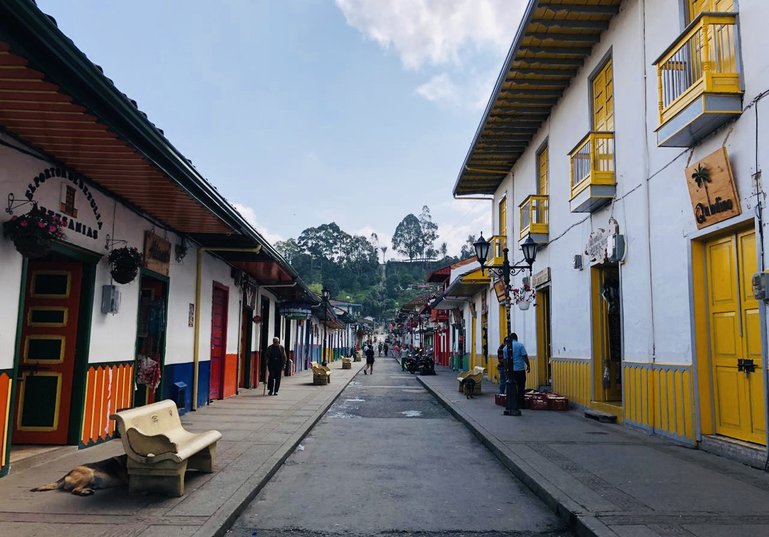
Salento, Quindío
Hiking in Cocora Valley
One of the most beautiful landscapes in the country can be found in the Cocora Valley, renowned for the vast fields of Colombia's national tree, the Quindío wax palm tree, which at the same time represents the world's highest palm. This tree can grow as high as 70 metres and has a long lifespan of up to 200 years. The valley is a protected natural park and is located in the central cordillera of the Colombian Andes.
From the main plaza of Salento, you can transport in one of the typical Jeep Willys and get to the Cocora Valley. The journey takes less than half an hour. Once you arrive, you'll have the opportunity to hike through the palm forest, get to viewpoints to enjoy the view of the entire valley, take great photos of the natural environment around you and visit the Acaime natural reserve of hummingbirds (Casa de los Colibrís). The whole circuit is about 12 kilometres long and you can spend the day at your own pace to explore and enjoy the beautiful landscape. You'll need comfortable clothes and shoes for hiking, a raincoat, camera, water and snacks. Horseback riding is another way to discover the valley, if you prefer not to hike.
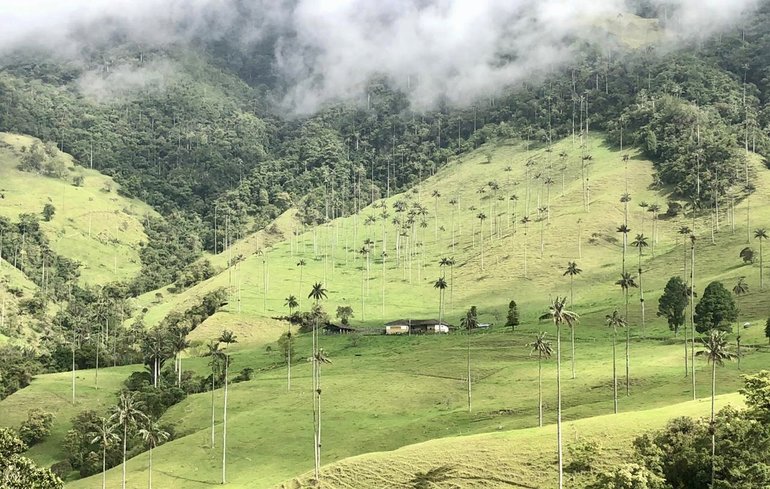
Cocora Valley, Quindío
Filandia
Filandia is another beautiful coffee town, just 30 kilometres away from Pereira. Its name comes from the combination of the Latin fila and the word Andean, and it means the Andean daughter. Although it shows many similarities with the neighbour town of Salento, Filandia attracts not many tourists. If you enjoy less crowded places, this is the one for you.
In the heart of Filandia you will come across the Calle del Tiempo Detenido, one of the streets with great architecture where you can appreciate the cultural value of the town. In the main plaza you'll find the old church of Maria Inmaculada dated back to 1905. What makes this building so special is the technique of bahareque that was used in its construction. This technique has been applied since the old times and is based on a mixture of raw materials, such as wood, bamboo, mud and straw, which people use to build their houses.
Another place worth to visit is the Illuminated Hill Viewpoint (Mirador Colina Iluminada Del Quindío) that offers great panoramic views. From this 27-meter-tall hill you can observe the town of Filandia and the beautiful landscapes of the surrounding mountains. If the sky is clear, you can even see other towns of the departments of Quindío, Risaralda and Valle del Cauca.
Accommodation in Filandia is available here.
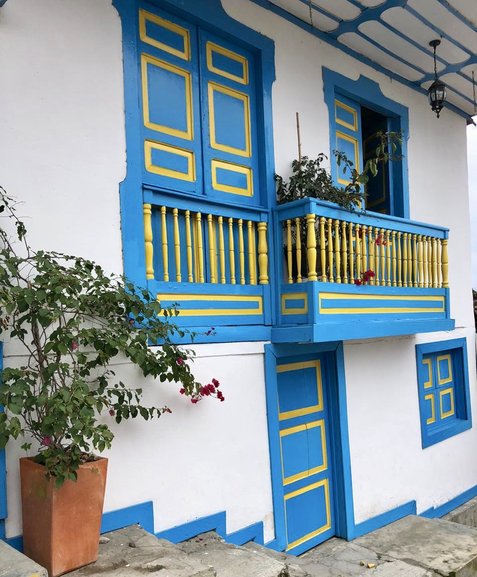
Filandia, Quindío








